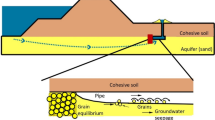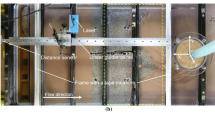Abstract
With the utilization of underground space, backward erosion piping (BEP) has been observed in many underground structures (e.g., shield tunnels) founded on sandy aquifers. However, due to invisibility, the geometry of the eroded pipe and its spatial evolution with time during the piping process was still not clear. In this study, we developed a Hele-Shaw cell to visualize the dynamic progression of BEP. With imaging process technology, we obtained a typical process of BEP (the erosion process can be divided into a piping progression phase and a piping stabilization phase), quantitatively characterized the formation of erosion pipes, and compared the patterns of erosion (e.g., the erosion area A and the maximum erosion radius Rmax) that spontaneously develop under different fluxes of water. The most interesting finding is that the sand grains in a thicker Hele-Shaw model are easier to dislodge, which is possibly due to the granular system in a thicker model having more degrees of freedom, reducing the stability of the sand grains.
摘要
目的
粉土、粉(细)砂土承压含水层中的盾构隧道出现渗漏时,土颗粒会在渗流力作用下液化悬浮并随地下水涌入隧道,致使隧道外土层在高速水流侵蚀下快速流失,引起隧道受力模式改变,进而造成衬砌结构的连续破坏(损)甚至垮塌。特别地,当渗漏点位于隧道底部时,侵蚀过程类似于水利大坝中的向源侵蚀,即逆着水流方向在隧道结构底部产生侵蚀空腔,从而导致隧道底部因失去土层支撑而产生大范围沉降和错台。为研究盾构隧道结构底部某点处由径向水流(水流向漏点汇聚)引起的向源侵蚀过程及侵蚀区形态,本文采用物理学中的经典装置,即赫尔-肖氏薄板,开展一系列可视化的模型试验,研究了水流速度及试样厚度对侵蚀过程及侵蚀形态的影响,以加深对向源侵蚀机制的理解。
创新点
1. 研制了用于研究汇聚流下向源侵蚀过程的赫尔-肖氏薄板仪器;2.清晰地捕捉了向源侵蚀动态发展过程;3. 揭示水流速度及试样厚度对侵蚀过程及侵蚀形态的影响。
方法
1. 采用恒流速试验,模拟瞬间施加水流下的向源侵蚀过程;2. 通过数字图像处理技术,定量描述向源侵蚀动态发展过程;3. 通过调整板间距及入流速度,分析试样厚度及水流大小对侵蚀过程及形态的影响。
结论
1. 瞬时恒流下的向源侵蚀过程可分为侵蚀发展和侵蚀稳定两个阶段。2. 瞬时水流速度越大,侵蚀区的形状表现为分叉越多,最大侵蚀半径越大。3. 试样越厚,向源侵蚀越容易在赫尔-肖氏薄板中启动;同时侵蚀区面积越大,半径也越大。
Similar content being viewed by others

References
Akrami S, Bezuijen A, van Beek V, et al., 2021. Analysis of development and depth of backward erosion pipes in the presence of a coarse sand barrier. Acta Geotechnica, 16(2):381–397. https://doi.org/10.1007/s11440-020-01053-0
Al-Housseiny TT, Tsai PA, Stone HA, 2012. Control of interfacial instabilities using flow geometry. Nature Physics, 8(10):747–750. https://doi.org/10.1038/nphys2396
Cheng X, Xu L, Patterson A, et al., 2008. Towards the zero-surface-tension limit in granular fingering instability. Nature Physics, 4(3):234–237. https://doi.org/10.1038/nphys834
Hele-Shaw HS, 1898. The flow of water. Nature, 58(1489): 34–36. https://doi.org/10.1038/058034a0
Holtzman R, Szulczewski ML, Juanes R, 2012. Capillary fracturing in granular media. Physical Review Letters, 108(26):264504. https://doi.org/10.1103/PhysRevLett.108.264504
Huang HY, Zhang FS, Callahan P, et al., 2012. Granular fingering in fluid injection into dense granular media in a Hele-Shaw cell. Physical Review Letters, 108(25):258001. https://doi.org/10.1103/PhysRevLett.108.258001
Neyer JC, 1984. Soft ground tunnel failures in Michigan. Proceedings of the International Conference on Case Histories in Geotechnical Engineering, p.1429–1434.
Pol JC, van Klaveren W, Kanning W, et al., 2021. Progression rate of backward erosion piping: small scale experiments. Proceedings of the 10th International Conference on Scour and Erosion.
Rice J, van Beek V, Bezuijen A, 2021. History and future of backward erosion research. Proceedings of the 10th International Conference on Scour and Erosion, p.1–23.
Richards KS, Reddy KR, 2012. Experimental investigation of initiation of backward erosion piping in soils. Géotechnique, 62(10):933–942. https://doi.org/10.1680/geot.11.P.058
Rosenbrand E, van Beek V, Bezuijen A, et al., 2022. Multiscale experiments for a coarse sand barrier against backward erosion piping. Géotechnique, 72(3):216–226. https://doi.org/10.1680/jgeot.19.P.358
Sandnes B, Flekkøy EG, Knudsen HA, et al., 2011. Patterns and flow in frictional fluid dynamics. Nature Communications, 2(1):288. https://doi.org/10.1038/ncomms1289
van Beek VM, Knoeff H, Sellmeijer H, 2011. Observations on the process of backward erosion piping in small-, medium- and full-scale experiments. European Journal of Environmental and Civil Engineering, 15(8): 1115–1137. https://doi.org/10.1080/19648189.2011.9714844
van Beek VM, Bezuijen A, Sellmeijer JB, et al., 2014. Initiation of backward erosion piping in uniform sands. Géotechnique, 64(12):927–941. https://doi.org/10.1680/geot.13.P.210
van Beek VM, van Essen HM, Vandenboer K, 2015. Developments in modelling of backward erosion piping. Géotechnique, 65(9):740–754. https://doi.org/10.1680/geot.14.P.119
Vandenboer K, 2019. A Study on the Mechanisms of Backward Erosion Piping. PhD Thesis, Ghent University, Ghent, the Netherland.
Vandenboer K, van Beek VM, Bezuijen A, 2018. 3D character of backward erosion piping. Géotechnique, 68(1):86–90. https://doi.org/10.1680/jgeot.16.P.091
Vandenboer K, Dolphen L, Bezuijen A, 2019a. Backward erosion piping through vertically layered soils. European Journal of Environmental and Civil Engineering, 23(11): 1404–1412. https://doi.org/10.1080/19648189.2017.1373708
Vandenboer K, Celette F, Bezuijen A, 2019b. The effect of sudden critical and supercritical hydraulic loads on backward erosion piping: small-scale experiments. Acta Geotechnica, 14(3):783–794. https://doi.org/10.1007/s11440-018-0756-0
Yao QL, Ding LQ, Sun DY, et al., 2007. Experimental studies on piping in single- and two-stratum dike foundations. Water Resources and Hydropower Engineering, 38(2): 13–18 (in Chinese). https://doi.org/10.3969/j.issn.1000-0860.2007.02.003
Zheng G, Cui T, Cheng XS, et al., 2017. Introduction and analysis of an accident in a shield tunnel. Chinese Journal of Geotechnical Engineering, 39(S2):132–135 (in Chinese). https://doi.org/10.11779/CJGE2017S2033
Acknowledgments
This work is supported by the National Engineering Laboratory for Digital Construction and Evaluation Technology of Urban Rail Transit (No. 2021GY01) and the National Natural Science Foundation of China (No. 41630641).
Author information
Authors and Affiliations
Contributions
Gang ZHENG designed the research. Jing-bo TONG and Tian-qi ZHANG processed the corresponding data. Tian-qi ZHANG wrote the first draft of the manuscript. Zi-wu WANG, Xun LI, Ji-qing ZHANG, Chun-yu QI, and Hai-zuo ZHOU helped to organize the manuscript. Yu DIAO revised and edited the final version.
Corresponding author
Additional information
Conflict of interest
Gang ZHENG, Jing-bo TONG, Tian-qi ZHANG, Zi-wu WANG, Xun LI, Ji-qing ZHANG, Chun-yu QI, Hai-zuo ZHOU, and Yu DIAO declare that they have no conflict of interest.
Electronic supplementary materials
Section S1
Electronic supplementary materials
Rights and permissions
About this article
Cite this article
Zheng, G., Tong, Jb., Zhang, Tq. et al. Visualizing the dynamic progression of backward erosion piping in a Hele-Shaw cell. J. Zhejiang Univ. Sci. A 23, 945–954 (2022). https://doi.org/10.1631/jzus.A2100686
Received:
Accepted:
Published:
Issue Date:
DOI: https://doi.org/10.1631/jzus.A2100686
Key words
- Backward erosion piping (BEP)
- Dynamic progression
- Hele-Shaw cell
- Visualize
- Imaging processing technology



